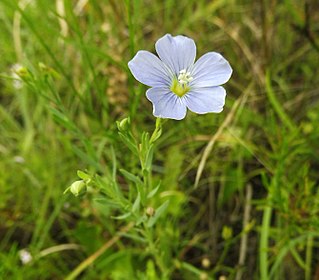
New Zealand flax describes the common New Zealand perennial plants Phormium tenax and Phormium colensoi, known by the Māori names harakeke and wharariki respectively. Although given the common name 'flax' they are quite distinct from the Northern Hemisphere plant known as flax

Linum bienne, the pale flax, is a flowering plant in the genus Linum, native to the Mediterranean region and western Europe, north to England and Ireland.

Linaceae is a family of flowering plants. The family is cosmopolitan, and includes about 250 species in 14 genera, classified into two subfamilies: the Linoideae and Hugonioideae . Leaves of the Linaceae are always simple; arrangement varies from alternate to opposite or whorled. The hermaphroditic, actinomorphic flowers are pentameric, or very rarely tetrameric.
The Neolithic founder crops are the eight plant species that were domesticated by early Holocene farming communities in the Fertile Crescent region of southwest Asia, and which formed the basis of systematic agriculture in the Middle East, North Africa, India, Persia and Europe. They consist of flax, three cereals and four pulses, and are the first known domesticated plants in the world. Although domesticated rye occurs in the final Epi-Palaeolithic strata at Tell Abu Hureyra, it was insignificant in the Neolithic Period of southwest Asia and only became common with the spread of farming into northern Europe several millennia later.

The Arboretum at the University of California, Santa Cruz, also called the UCSC Arboretum, is an arboretum located on the campus of the University of California, Santa Cruz, in Santa Cruz, California in the United States.

Linum perenne, the perennial flax, blue flax or lint, is flowering plant in the family Linaceae, native to Europe, primarily in the Alps and locally in England.
The flora of the Chatham Islands consists of around 388 terrestrial plant species, of which 47 are endemic. The Chatham Islands make up the Chatham floristic province of the Neozeylandic Region of the Antarctic Kingdom.

Linum grandiflorum is a species of flax known by several common names, including flowering flax, red flax, scarlet flax, and crimson flax. It is native to Algeria, but it is known elsewhere in Northern Africa, Southern Europe and in several locations in North America as an introduced species. It is an annual herb producing an erect, branching stem lined with waxy, lance-shaped leaves 1 to 2 centimeters long. The inflorescence bears flowers on pedicels several centimeters long. The flower has 5 red petals each up to 3 centimeters long and stamens tipped with anthers bearing light blue pollen. It can on occasion be found as a casual well outside its normal established range; records from the British Isles, for example, are reasonably frequent but, grown as an annual, it rarely persists for more than one season.
Linum marginale, known by the common name of native flax or Australian flax, is a short lived perennial flowering herb, native to Australia. A slender, wispy, upright plant, growing to around 1 metre high, Native Flax is often overlooked when not in flower. It should not be confused with species of Wahlenbergia, which occurs in the same area and can appear similarly. Like most species of Linum, Linum marginale can be used to produce useful fibre, but is not grown on a commercial level for this purpose. Native flax has small linear blue green leaves, often pushed quite close to the stem. To the untrained eye from a distance, in may appear to have no leaves. Unlike most other species of flax which have yellow flowers, Linum marginale beaks into sprays of large, electric blue flowers in spring and early summer. The flowers have five petals and form at the top of each wiry stem of the plant. Flowers are replaced in summer by small, globular, papery capsules, about 3 mm across, containing a cluster of buff coloured, sesame-like seeds. Like many southern Australian flowers, the plant dies back in summer, but reshoots the following autumn when the rains return.
Linen is a textile made from the fibers of the flax plant, Linum usitatissimum.

Harold Henry Flor (1900–1991) was a plant pathologist famous for proposing the gene for gene hypothesis of plant-pathogen genetic interaction whilst working on rust of flax. He received his PhD from the University of Minnesota in 1929. He proposed term "Avirulence gene". He worked for three years at Washington State University and the rest of his career at North Dakota State University where he came up with his hypothesis.
Golden flax is a common name for several plants in the flax family (Linaceae), and may refer to:
Aliphatic (R)-hydroxynitrile lyase is an enzyme with systematic name (2R)-2-hydroxy-2-methylbutanenitrile butan-2-one-lyase . This enzyme catalyses the following chemical reaction

Linum pratense, commonly called meadow flax, is a species of flowering plant in the flax family (Linaceae). It is native to the United States, where it is found in the south-central and southwestern regions of the country. Its natural habitat is in dry, open prairies over calcareous or sandy soil. It can be found in both intact and disturbed communities.
This page is based on this
Wikipedia article Text is available under the
CC BY-SA 4.0 license; additional terms may apply.
Images, videos and audio are available under their respective licenses.














